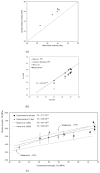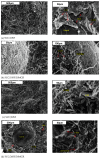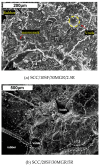Hooked-End Steel Fibers Affecting Damping Ratio of Modified Self-Compacting Concrete with Rubber and Marble/Granite Additions
- PMID: 39685153
- PMCID: PMC11642231
- DOI: 10.3390/ma17235717
Hooked-End Steel Fibers Affecting Damping Ratio of Modified Self-Compacting Concrete with Rubber and Marble/Granite Additions
Abstract
The aim of this investigation is to determine the effects of hooked-end steel fibers on both the fresh and hardened properties of modified self-compacting concretes (SCC). For this purpose, the steel fibers are associated with other residue contents (i.e., marble, granite, and rubber). These concatenated material contents constitute a novelty since no investigations are reported. It is found that with the increase in rubber content, a better ability to absorb energy is observed. This indicates that a good alternative to structural material is provided. Fresh properties are evaluated by using flow, T500 time, V-funnel, and J-ring methods. The mechanical behavior is evaluated in terms of compressive strength, tensile strength, static and dynamic modulus of elasticity, and damping ratio. Experimental results of the water absorption, porosity, and density are also attained. It is also found that an SCC mixture containing steel fiber, marble/granite residue, and rubber content is a potential mixture to be considered when designing in SCC associated with an improved damping ratio. Although the rubber content decreases the mechanical behavior and slump flow, the concatenated utilization of marble/granite residues and steel fiber contents provides a slight improvement in the damping result. An environmental benefit can also be associated since cement consumption is decreased with marble additions.
Keywords: composite material; mechanical properties; microstructural array; rubber content; self-compacting concrete; waste residues.
Conflict of interest statement
The authors declare no conflicts of interest.
Figures









References
-
- Okamura H., Ouchi M. Self-Compacting Concrete. J. Adv. Concr. Technol. 2003;1:5–15. doi: 10.3151/jact.1.5. - DOI
-
- EFNARC . The European Guidelines for Self-Compacting Concrete—Specification, Production and Use. The European Federation of Specialist Construction Chemicals and Concrete Systems; Flums, Switzerland: 2005. 63p
-
- Topçu I.B., Bilir T., Uygunoğlu T. Effect of waste marble dust contente as filler on properties of sel-compacting concrete. Constr. Build. Mater. 2009;23:1947–1953. doi: 10.1016/j.conbuildmat.2008.09.007. - DOI
-
- Manikandan M., Felixkala T. Experimental study on properties of granite waste in self compacting concrete. Indian J. Appl. Res. 2015;5:128–130.
-
- Boukhelkhal A., Azzouz L., Belaïdi A.S.E., Benabed B. Effects of marble powder as a partial replacement of cement on some engineering properties of self-compacting concrete. J. Adhes. Sci. Technol. 2016;30:2405–2419. doi: 10.1080/01694243.2016.1184402. - DOI
Grants and funding
LinkOut - more resources
Full Text Sources
Research Materials

